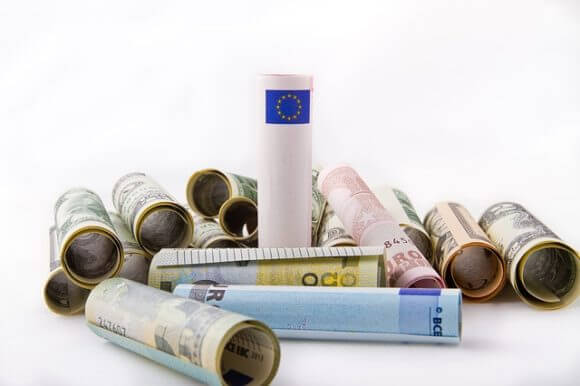The EUR/RON exchange rate witnessed stronger fluctuations in the first half of 2017 Q1, before embarking on an almost constant uptrend. Its behavior, only partly correlated with that of the exchange rates of the main currencies in the region, reflected this time primarily the changes in investor sentiment vis-à-vis the local economy and financial market, brought about by domestic events/developments, and, to a smaller extent, the external influences.
The EUR/RON dropped sharply in the first ten‑day period of January, in a move slightly exceeding the increase seen in the previous month. The fall can be ascribed to the fading away of the uncertainty about the incoming cabinet, being also underpinned by the temporary improvement in global risk appetite, amid favourable signals on macroeconomic developments across the euro area and the US38. External influences were subsequently dampened by growing investor fears stemming from the 2017 budget construction, also given the tensions that emerged on the social and political scene towards end January. On this backdrop, the exchange rate saw its fall come to a halt and near stabilised at relatively high levels.
The EUR/RON exchange rate swung again widely in early February and embarked on an upward trend thereafter. The move largely different from those prevailing across the region most likely reflected investor concerns over the protracted domestic political strains, but notably over the clearer risk of fiscal policy easing to a higher extent than forecasted in the newly‑passed 2017 budget. The ensuing effects more than offset those stemming from: higher than expected rise in fourth quarter GDP and a relative slowdown in the widening of current account deficit, as shown by the statistical data released in that period, and from the ruling of unconstitutionality for the law on converting CHF denominated loans into leu denominated loans at the historical exchange rate.
The EUR/RON rate tended to rise even after the domestic political environment had calmed down, albeit at a slower pace, coming alongside the exchange rates of the other currencies in the region under the impact of gradually stronger expectations on the Fed conducting a further rate hike in its meeting of 14‑15 March. After making public this decision, the exchange rates of the Polish zloty and the Hungarian forint saw a decline given that, contrary to some investor expectations, the interest rate path anticipated by FOMC members had remained unchanged. The EUR/RON reflected this influence with a certain lag, as it continued to rise for a short while, only to embark in its turn on a downtrend in the closing day period of March.
In the interbank forex market, these relatively frequent changes in context led to a step-up in non-residents’ activity. The balance of non‑residents’ transactions turned positive in January largely offsetting the short‑lived rise in residents’ net demand for foreign currency, before returning and falling deeper into negative territory thereafter.
However, for the period as a whole, the overall market deficit slightly contracted compared with the previous quarter.
In 2017 Q1, the domestic currency depreciated against the euro by 0.7 percent in nominal terms and 0.9 percent in real terms. In relation to the US dollar, the leu strengthened by 0.6 percent in nominal terms and 0.4 percent in real terms, given the former’s weakening against the euro. Looking at the average annual exchange rate dynamics in 2017 Q1, the leu saw its nominal depreciation diminish against the euro and widen versus the US dollar.
For further information.

